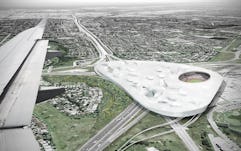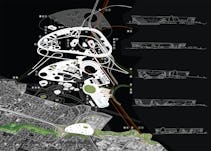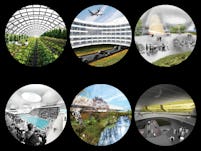The GLM Gateway, Toronto ON
SPECULATIVE URBAN DESIGN PROPOSAL FOR THE GREAT LAKES MEGAREGION







Situated within the regional mobility and energy systems of our Conduit Urbanism project - and located within the massive intersection of the 401 and 427 highways, adjacent to Toronto’s Pearson International Airport, the Gateway rises as a monumental landform: a contemporary acropolis constructed not for defense but for assemblage. This is a place of collective citizenship,
orientation, physical, and spiritual life. The Gateway is a port of arrival as well as a space of public apprehension where social questions of inclusion and exclusion are conflated within one heterotopic complex. Here, thousands of new Canadian immigrants and travellers arrive by air to encounter and intermingle with local residents and visitors to and from the megaregion.
The Gateway is networked with the surrounding city via an AirRail link, public transportation, private last-mile hybrid fueled vehicles, and to Toronto’s landscape of extensive ravine systems via bicycle access. It draws not only on the vast populations of the megaregion, but also on the highly diverse populations that have come to characterize the city of Toronto and its surrounding urban areas. The great arrival hall becomes a mixing chamber where residents confront the space between new ideals and established ones. Contained within this megastructure are public assembly halls totaling over 200,000 seats: some take the form of Olympic-scaled stadia, rinks, and athletic facilities, while others accommodate congregations of religions and sects represented in the GLM. Gathering a diverse population, this space of theaters and temples acts as a crucible from which a sense of publicness and collectivity can emerge through social participation and play.
Interlaced with the spaces of gathering are research facilities for collaboration across the various public universities, government agencies, and emerging industry sectors that are concentrated in this part of the megaregion, and revealed in the actor-network analysis. The Gateway houses a regional think-tank that conducts interdisciplinary research on issues related to global migration, the global spread of infectious disease, new methods of food production, agricultural science, kinetic medicine, and nutrition. As Toronto is a major host city for international sporting events, a new joint U.S.-Canadian high-performance training center is also located here. International athletes can train, reside, and participate in the space of physical and cultural bodies. The complex is positioned to be able to host major international competitions, events, and symposia enabled by its adjacency to three significant modes of international travel: the airport, the maglev, and the highway.